The show gardens at the Chelsea Flower Show each May just zing with the stunning colours of the irises in bloom and they really are one of the main attractions (apart from roses) that are on display. Being ‘show-stoppers’, their impact allows the designers to then infill and arrange around them the more delicate flowers and foliage to an harmonious effect. Visitors admire, with ‘oooh’s and aaah’s’ at the soft, subtle shades and again, of the deeply-rich and vibrant colours of each and every iris grouping.
The name Iris means rainbow and in Greek mythology ‘Goddess of the Rainbow’. The petals and roots of several species, including Iris germanica (bearded) and Iris pallida (Dalmatian/Orris root) are used in the beauty industry, in the manufacture of perfumes, lotions, in food such as spices and even added to gin. Seemingly, the dried root, after 3 years, has the aroma of violets. This industry goes back to the ancient Greeks, Romans and Egyptians and probably long before their time.
I have an Iris pallida flowering in my front garden, low-growing, which is highly fragrant. This was kindly given to me by Penny S some years ago. The flower is fading so unfortunately not worthy of a photograph but it certainly should be grown, as the variegated grey-foliage blends nicely with neighbouring plants. I wouldn’t be without it.
My number-one favourite, though, is Iris ‘Langport Wren’, a Kelways‘ introduction from 1973 and deservedly worthy of the RHS Award of Garden Merit. It was flowering in my front garden until a few days ago when the slugs/snails chomped its head off! The fragrance is reputedly of orange and chocolate – but I wouldn’t know as I haven’t had the chance to find out!!! The first photo below is of this delectable flower, a painterly amalgamation of browns, purples and russets, growing in Margaret T’s garden.

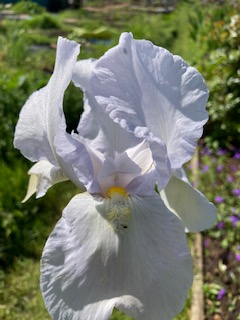



Next up is Iris ‘White City’, a tall, stately and handsome bearded Iris, bred by Olive Murrell at Orpington Nurseries and introduced in 1939. This clump is growing in Margaret T’s allotment, flowering over a long period. The large, fragrant flowers are palest blue, fading to white with orange-yellow throat markings.
Pat K’s rare Iris ‘Croftway Lemon’ has a delectably sweet fragrance and a flower consisting of many shades of lemon, which Vincent Van Gogh would surely have wanted to paint! This tall variety was bred by MJR Spencer of West Sussex and introduced in 1990. Pat had previously donated several plants to a CABAHS Plant Sale so there are a few lucky recipients out there with a very rare, garden treasure!
Iris ‘Fountain of Youth’ is very striking in appearance, with its contrasting purple and white petals, which is growing in Viv P’s garden. This variety was bred by Ben Hager (USA) and introduced in 1998. Ben Hager bred an absolutely vast number of different irises and is especially known for his delicately-soft-pink varieties.
Another of Viv’s irises is Iris ‘Bold Print’, an attractive, lower-growing variety that spreads well, also from the USA and was bred by Joseph Gatty and introduced in 1982.
There are a number of irises on Margaret T’s plot, their names not known, but I’ve included photographs and one in particular, inky-blue-purple in colour, is a stunner. Kindly given to us by a neighbouring plot-holder, I potted several up for a CABAHS plant sale a year or so ago and I’m now wondering if any lucky purchasers were CABAHS members?


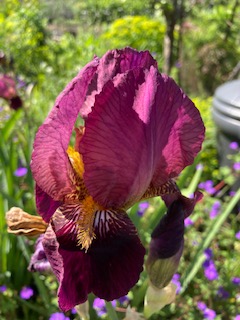


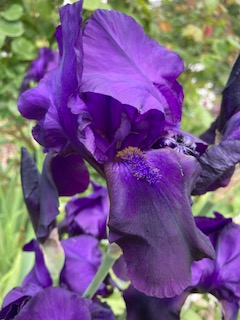


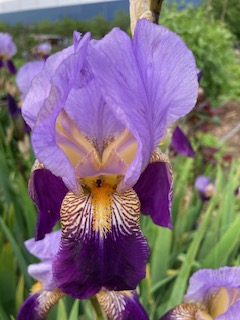

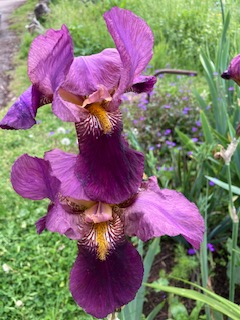
The photographs are numbered so you can let us know if you can name any.
Margaret tells me that she neglects her irises! Whatever that involves, it really pays off, the result being a glorious display throughout May. I’m told that every 3 to 4 years, the clumps are split and the leaves are reduced by two-thirds to form a fan-shape, cutting the old stems lowest. The rhizomes and roots are then checked over to ensure they are healthy, well-rooted and stable. When replanting clumps, this should be in good soil, with each rhizome facing south and exposed to the sun. In late winter, a mulch of manure is placed on the soil around the base of the exposed rhizomes.
Whether it’s neglect or good garden practice, Margaret’s irises are definitely Kidbrooke’s ‘show-stoppers’.
Anna L
I’m amazed that the iris respond to a mulch of manure as we are always told to plant in sandy poor soil. Maybe we’ve got it wrong all these years.
LikeLike